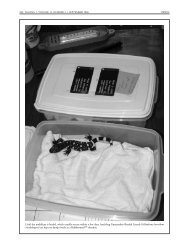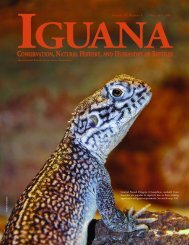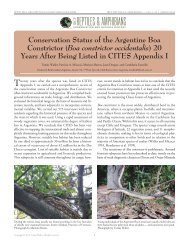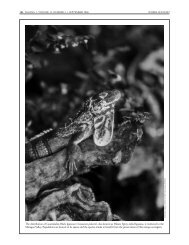Spiny-tailed Iguanas (Ctenosaura similis) in Venezuela
Spiny-tailed Iguanas (Ctenosaura similis) in Venezuela
Spiny-tailed Iguanas (Ctenosaura similis) in Venezuela
You also want an ePaper? Increase the reach of your titles
YUMPU automatically turns print PDFs into web optimized ePapers that Google loves.
156 IGUANA • VOLUME 15, NUMBER 3 • SEPTEMBER 2008 POWELL AND HENDERSON<br />
which was hidden under the litter, we moved a leaf and accidentally<br />
startled the Alsophis, which struck at us several times before<br />
releas<strong>in</strong>g the hawk and mov<strong>in</strong>g <strong>in</strong>to the litter, reveal<strong>in</strong>g a superficial<br />
head wound as it fled.<br />
After release, the hawk stumbled on an apparently numbed<br />
right leg and seemed unable to flex its right w<strong>in</strong>g; upon return<strong>in</strong>g<br />
to the site approximately three hours later, however, we<br />
observed the bird, seem<strong>in</strong>gly unharmed, fly<strong>in</strong>g between trees.<br />
Acknowledgements<br />
We thank Bob Powell and Bob Henderson for provid<strong>in</strong>g com-<br />
Normally diurnal West Indian anoles (Polychrotidae: Anolis)<br />
are known to exploit <strong>in</strong>sects attracted to artificial lights<br />
well <strong>in</strong>to the night (e.g., Perry and Fisher 2006, Henderson and<br />
Powell 2009). Secondary exploitation of nocturnal anoles by a<br />
typically diurnal predator, the Puerto Rican Racer (Alsophis portoricensis),<br />
has been reported on hotel grounds on Guana Island,<br />
British Virg<strong>in</strong> Islands (Perry and Lazell 2000).<br />
At 1915 h (transition to full dark) on 18 June 2008, we<br />
observed a male Dom<strong>in</strong>ican Racer (Alsophis antillensis sibonius;<br />
SVL 525 mm, tail 247 mm) <strong>in</strong> a forag<strong>in</strong>g position at the base<br />
of a light frequently used by a nocturnally active Dom<strong>in</strong>ican<br />
Anole (Anolis oculatus). The observation occurred on the<br />
grounds of the Sunset Bay Club at Batali Beach, on the leeward<br />
coast of Dom<strong>in</strong>ica, Lesser Antilles.<br />
Based on our experiences, exploitation of the night-light<br />
niche has become commonplace among West Indian anoles<br />
associated with urban areas and other situations <strong>in</strong> which artificial<br />
light<strong>in</strong>g is prevalent at night (e.g., hotels, resorts). However,<br />
both situations <strong>in</strong> which snakes have been observed exploit<strong>in</strong>g<br />
the night-light niche (Guana Island, Batali Beach) have been<br />
“snake-friendly”; that is, guests and personnel of the hotels are<br />
<strong>in</strong>structed not to harm snakes that enter areas frequented by<br />
humans. Under more typical circumstances (i.e., where snakes<br />
would be killed or, at least, removed from the area), we doubt<br />
that snakes would have the opportunity to learn to exploit this<br />
potentially productive trophic niche.<br />
Acknowledgements<br />
Marcella and Roger Dutrieux Cools, owners of the Sunset Bay<br />
Club tolerated our eccentricities. Mr. Arl<strong>in</strong>gton James, Forest<br />
Officer, Forestry, Wildlife, and Parks Division, M<strong>in</strong>istry of<br />
ments on this note. This observation was made while conduct<strong>in</strong>g<br />
research on Iguana delicatissima <strong>in</strong> Dom<strong>in</strong>ica. That project<br />
is funded through the Center for Conservation and Research for<br />
Endangered Species (CRES) at the Zoological Society of San<br />
Diego.<br />
Literature Cited<br />
BirdLife International 2004. Buteo platypterus. In: IUCN 2007. 2007 IUCN<br />
Red List of Threatened Species. .<br />
Malhotra, A. and R.S. Thorpe. 1999. Reptiles & Amphibians of the Eastern<br />
Caribbean. Macmillan Education, Ltd., Oxford and London, UK.<br />
Exploitation of the Night-light Niche<br />
by a Dom<strong>in</strong>ican Racer<br />
Robert Powell 1 and Robert W. Henderson 2<br />
1 Department of Biology, Avila University, Kansas City, MO 64145, USA (robert.powell@avila.edu)<br />
2 Section of Vertebrate Zoology, Milwaukee Public Museum, Milwaukee, WI 53233, USA (henderson@mpm.edu)<br />
<br />
A Dom<strong>in</strong>ican Anole (Anolis oculatus) exploit<strong>in</strong>g the night-light niche<br />
on the grounds of the Sunset Bay Club at Batali Beach, Dom<strong>in</strong>ica.<br />
ROBERT POWELL








